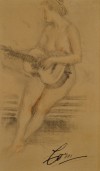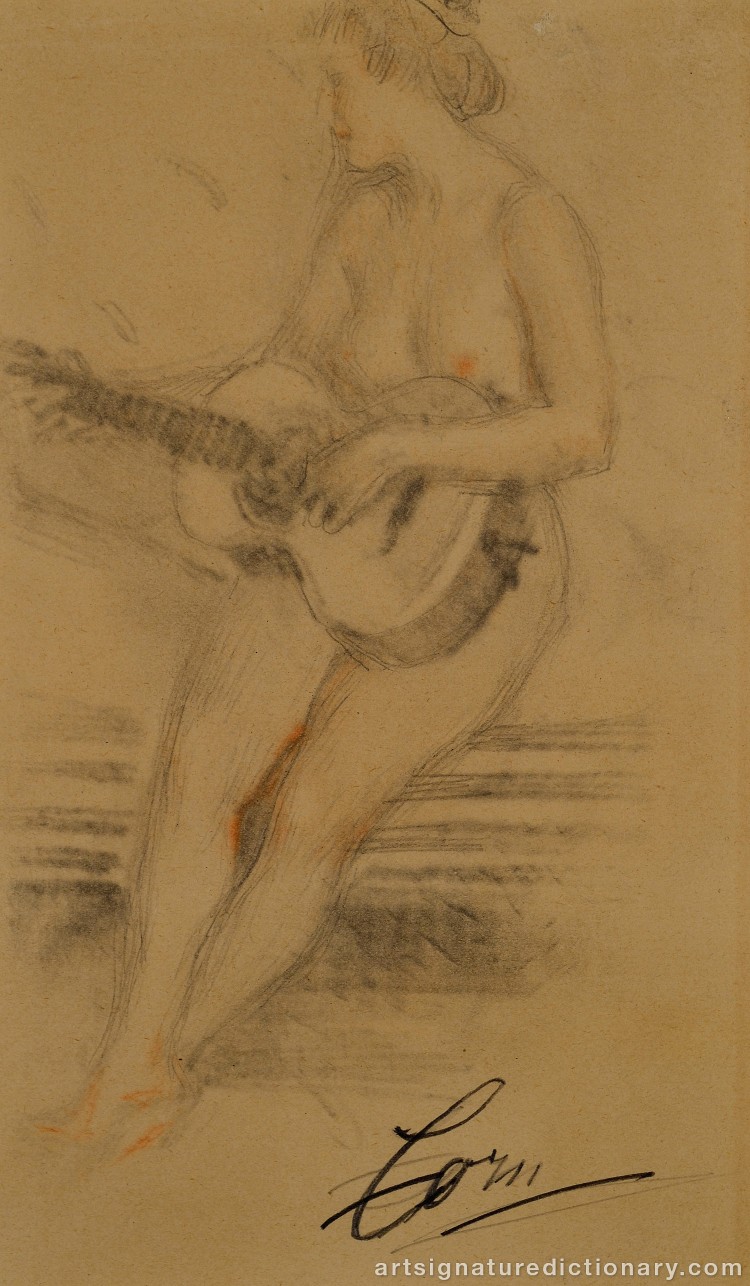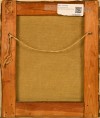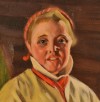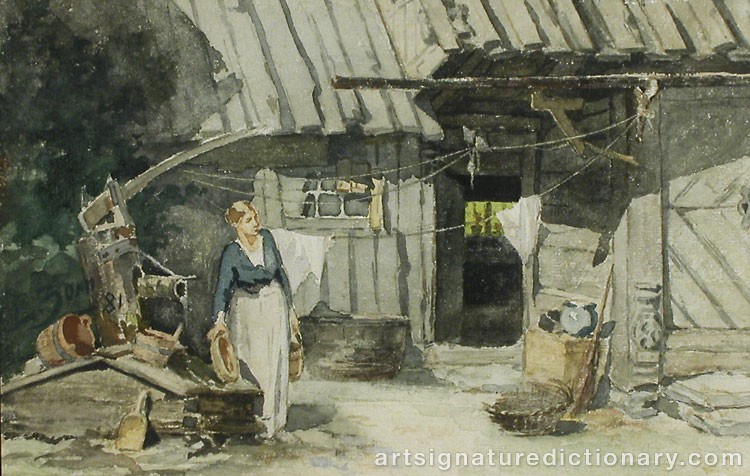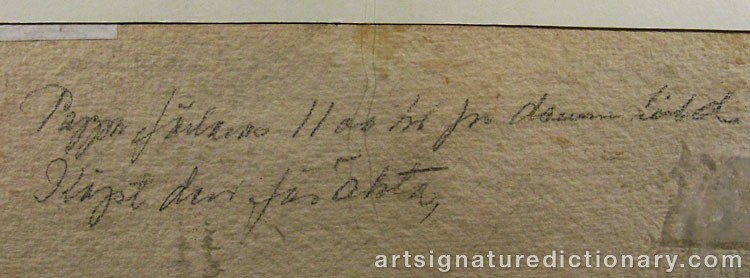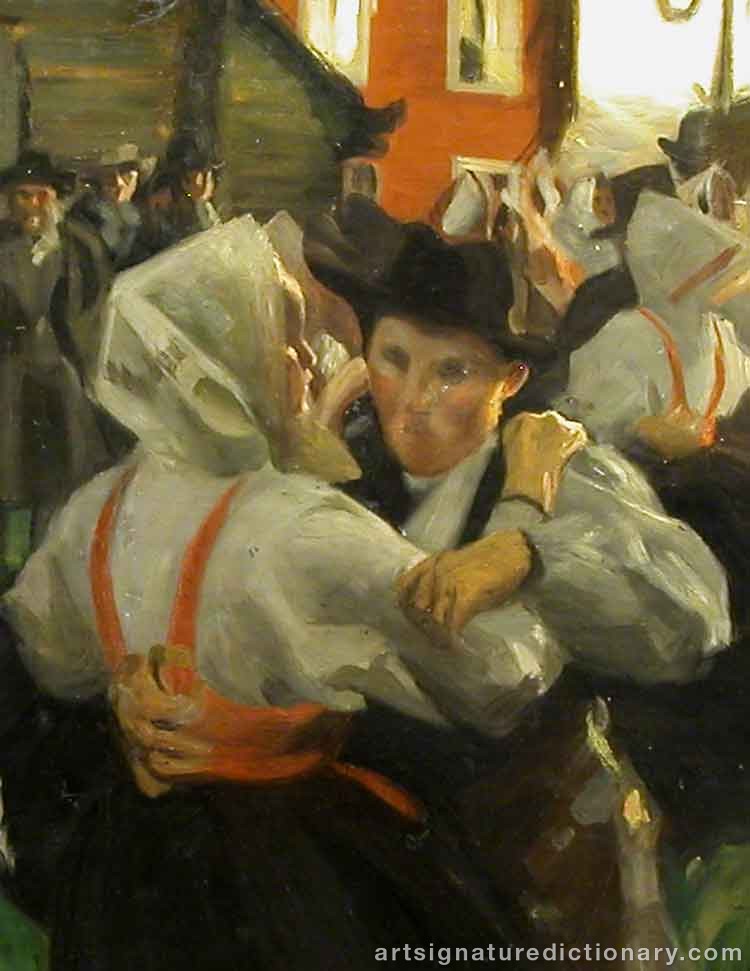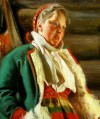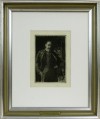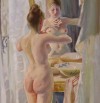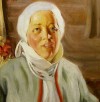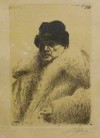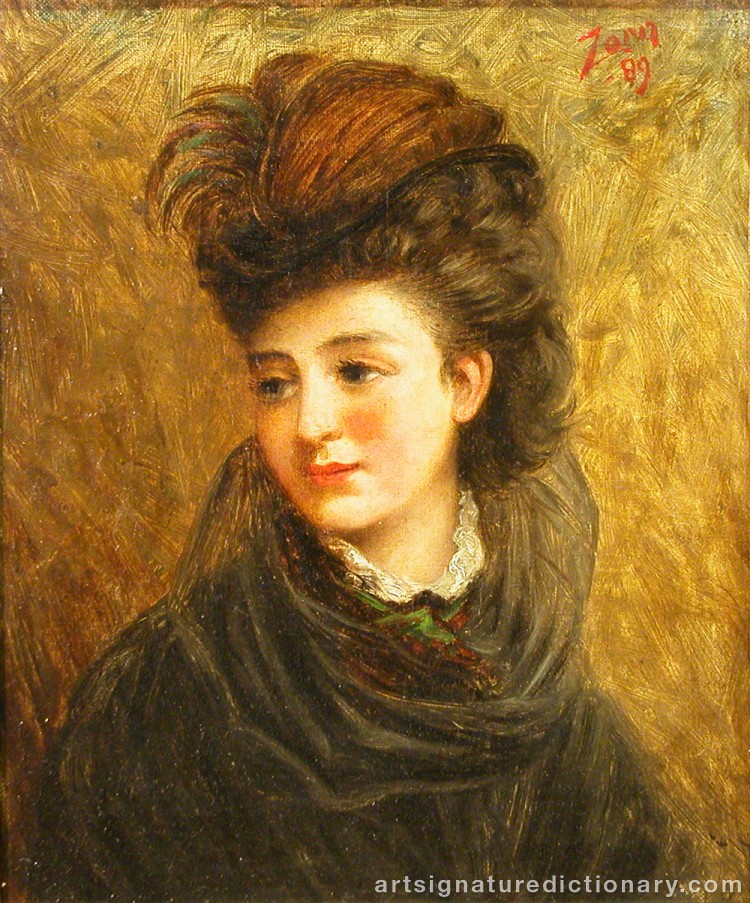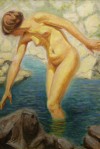
Anders ZORN
1860–1920, Sweden
Signatures & monograms
87 signatures and monograms by Anders Zorn on drawing, graphic, print, painting, watercolour and sculpture. Compare authentic and documented counterfeit examples to study signature characteristics.

Signature proven counterfeit
Drawing, signed "Zorn," woman playing guitar, size about 27x12 cm. Ostensibly representing a genuine painting by renowned artist Anders Zorn. The painting was submitted to an online auction house for sale where staff suspect that the painting was a forgery. The painting was seized and subsequent utrednig showed that the painting is a forgery.

Signature proven counterfeit
Watercolor, signed "Zorn", picturing a young woman with the title "Daughter of Sweden", size about 65x48 cm. Ostensibly picturing a genuine painting by renowned artist Anders Zorn. The painting was submitted to a major auction house for sale where staff suspect that the painting was a forgery. The painting was confiscated and subsequent utrednig showed that the painting is a forgery.

Signature proven counterfeit
Oil on canvas, portrait of woman (Dalkulla), signed "Zorn", size 40x33 cm. The painting was for sale at an online auction house in Stockholm in spring 2013. It had been submitted along with another counterfeit painting signed "Bruno Liljefor". The painting has been investigated by technical and specialist expertise which found that the painting is not performed by the artist Anders Zorn nor signed by him. The district court: The painting bears a forged signature. If it comes on the market it can be used for criminal purposes. It shall be forfeited.

Signature proven counterfeit
Drawing, pencil and watercolor, oval 49x39 cm, portrait of little girl, signed "L Zorn". The painting was seized by police in a small auction house in Stockholm after notification that the painting is probably not an authentic painting by Anders Leonard Zorn. The submitter would sell the painting for his father's behalf. Investigation revealed that the painting had been sold by art dealers in Karlshamn, Sweden for SEK 65,000, dated receipt "Ängelholm September 1995". The deal also included a painting by artist Carl Larsson. The signature on the painting have been counterfeited in order to ostensibly appear to be an authentic painting by Anders Zorn. It has thus become a forgery and should be forfeited.

Signature proven counterfeit
Watercolor, signed L.Zorn -81, 18x28 cm, depicting a woman in the courtyard. The painting was seized in September 2010 with a major auction house in Stockholm. The owner had some years previously bought it from a small auction house in 8000 SEK in the belief that it was genuine. The painting was probably circulating for many years on the market, as a "real work" of Zorn. During examination of the painting has expertise demonstrated that neither painting or signature has been performed by Zorn. The District Court's decision: Seized watercolor painting signed L Zorn-81 (No. 2010-0201-BG23359. Case no. B333-11) shall, in a clear, safe and stable manner, be labeled as "counterfeit" on its back. Thereafter, the painting returned to the owner. Warning! The painting may re-enter the market seemingly depicting an original work by Zorn. Probably abroad, where the court decision is not known.

Signature proven counterfeit
Etching, signed "Zorn" and dated 1906. The painting was submitted to a small auction house in Stockholm by a man from England to be sold online. But the auction house staff became suspicious of the painting's authenticity and summoned the police who took the painting seized for further investigation. When the police would interrogate the Englishman, he had disappeared - he had left the country! After the expert investigation and judgment declared that the painting is not genuine. It is a forgery. The man had also submitted two other paintings for sale. One painting signed with monogram "George Braque," and the other was signed "Olle Baertling". Although these were forged and can be seen on the respective artist page.

Signature proven counterfeit
Oil on canvas with counterfeit signature "Zorn". Motive: "Midsummer dance". This painting was presented to the Zorn Museum in the late 1970's. The staff explained that it was a falsely signed forgery. The owner stated that the painting was bought in the 1930s as an original painting by Zorn. With the help of fluorescent light, it is possible to see that a signature in the lower right corner has been covered over. During the decades around 1900, it was common to copy famous paintings at the National Museum of Art. The documentation at the National Museum of Art says that the painting Midsummer dance has been copied 19 times. This painting is probably one of these copies,which has been falsely signed later on. The copies were made for educational purposes, by art students or other artists. It is completely legal to copy a piece of art, as long as the artist’s name and the name of the copyist are displayed properly, and that the painting is marked as a copy, In this case, the painting was probably originally signed: “Zorn cop. + the name of the copyist”. However, by covering the name of the copyist and instead putting the signature of Anders Zorn on the painting, the painting has been transformed from a legal copy into a forged painting.

Signature proven counterfeit
Watercolor, motif "Marja", woman in traditional costume from Dalarna in Sweden. Signed Zorn in the lower right corner. Loan Amount €15,000. Valued at €50,000. The painting, along with eight other works, have been pledged with a Swedish pawnshop in Gothenburg. They have been submitted to a major auction houses in Stockholm for sale. All artwork in this seizure were fakes. They had been pledged by J.W. formerly known to the police for serious fraud and is also convicted for this. Another painting that was stored at the pawn shop for J.W. were also submitted to an auction house. Although this painting was a forgery. It is signed Toulose Lautrec.

Signature proven counterfeit
Oil on canvas. Counterfeit Signed signature "Zorn" dated in 1912. Motif "Braskkulla", (woman by the open fire). Anders Zorn painted original painting Fireplaces ball in 1907. This is a counterfeit signed copy dated in 1912, which could be due to a misunderstanding from the forger. It may be that the copy is made in 1912 and that the painting is one of the 55 copies, which were performed legally at the National Museum. The original signature has been painted over and replaced with a forged signature. The painting was seized in 1989 at Hotel Sheraton in Stockholm in conjunction with an art deal would be made up. A man was sentenced by the district court to prison for eight months for attempted aggravated fraud.

Signature proven counterfeit
Oil on canvas. Counterfeit signature "Zorn" indistinctly dated -98? Again, a counterfeit of the motif, "Braskkulla", (woman by the open fire). Anders Zorn painted original painting Fireplaces ball in 1907. This is probably a counterfeit signed copy, one of the 55 copies, which were performed legally at the National Museum.

Signature proven counterfeit
Oil on Masonite with a forged signature "Zorn" dated in 1902. The painting is part of a major fraud seizures of counterfeit art in Sweden known as: ”The Society of Art Friends”. Masonite was first sold commercially in 1928, Anders Zorn died in 1920. In other words, the painting could not possibly have been carried out by Anders Zorn. When lighting with UV light of the reverse side, was found one erased inscription: "Painted by Hanna Pauli". This is probably one of the Swedish artist Hanna Pauli's later works from the 1930s. The painting has a professional version, but does not seem complete. Hanna Pauli was certainly recognized as a talented artist, but an unfinished and unsigned portrait of an unknown woman, would not command a particularly high value. But after the painting had a forged signature of "Zorn" it became suddenly an attractive object. Leaderboard sold by the league "Society of Art Friends" for 50,000 crowns (ca.€5.000). The history of the "Society of Art Friends": Three men, aged 30, 37, and 40 years old, were caught in Stockholm, Sweden after a reconnaissance tip from police in Ängelholm, Sweden. Shortly afterwards, another two men were caught. In total, 48 house searches were made through out the nation from which 83 forged paintings were confiscated. Forged art had already been sold for millions of Swedish crowns. Victims of the gang were well known businessmen with considerable incomes. League had good help from educated art experts who have written certificate of authenticity to many of the fake paintings, often at very small remuneration. On a door to a flat in Stockholm the men had displayed a sign with the text “The Society of Art Friends”.

Signature proven counterfeit
Oil on canvas "Self-Portrait in his studio - 1986" with forged signature "Zorn" dated 1896. The painting is a copy of Anders Zorn's original painting owned by the National Museum in Stockholm. The painting is probably a copy performed legally at the National Museum and then had a forged signature. The painting is now in Police Museum in Stockholm


Signature proven counterfeit
Oil on canvas, signed Zorn, indistinctly dated, 56x34 cm. Associate Professor Hans Henrik Brummer, the Zorn museum in Mora Sweden, submitted the following statement: "The painting is a forgery. The is a copy in oil after a watercolor by Zorn signed in 1888, 81x50 cm. Reportedly owned the painting in 1945 by a private person. In the lower right corner is an old signature that is hidden by new layer of paint. On top of that, the forger painted "Zorn." The changing area is quite large and one can trace a long line of text below it. Probably a copy text which has been deleted. The District Court's assessment: The painting has become a forgery after it has changed and then been provided with a forged signature.

Signature proven counterfeit
Oil on canvas, 72x62 cm, signed Zorn. The painting is a copy of Zorn's oil painting "Hindar", which has the dimensions 91x61 cm. The girl left in the foreground is taken from "Hindar" and the seated girl is borrowed from Zorn's oil painting "Ute" available at Göteborg Museum of Art in Sweden. Between these two paintings is a time difference of 20 years. In the lower right corner is an area of blurred and provided with Zorn's signature. District Court: The painting is a forgery.

Signature proven counterfeit

Signature proven counterfeit

Signature proven counterfeit


Signature proven counterfeit

Signature proven counterfeit

Signature proven counterfeit

Signature proven counterfeit

Signature proven counterfeit

Signature proven counterfeit

Signature considered genuine

Signature considered genuine

Signature considered genuine

Signature considered genuine

Signature considered genuine

Signature considered genuine

Signature considered genuine

Signature considered genuine

Signature considered genuine

Signature considered genuine

Signature considered genuine
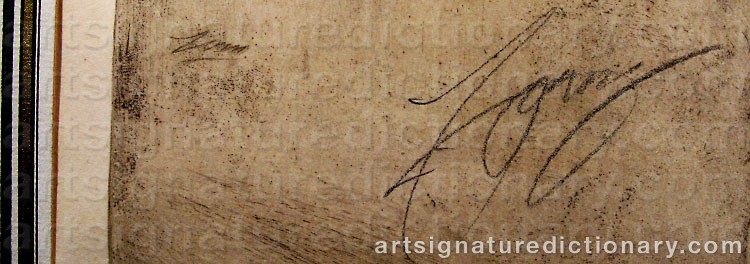
Signature considered genuine

Signature considered genuine

Signature considered genuine

Signature considered genuine

Signature considered genuine

Signature considered genuine

Signature considered genuine

Signature considered genuine

Signature considered genuine

Signature considered genuine

Signature considered genuine

Signature considered genuine

Signature considered genuine

Signature considered genuine

Signature considered genuine

Signature considered genuine

Signature considered genuine

Signature considered genuine

Signature considered genuine

Signature considered genuine

Signature considered genuine

Signature considered genuine

Signature considered genuine

Signature considered genuine

Signature considered genuine

Signature considered genuine

Signature considered genuine

Signature considered genuine

Signature considered genuine

Signature considered genuine

Signature considered genuine

Signature considered genuine

Signature considered genuine

Signature considered genuine

Signature considered genuine

Signature considered genuine

Signature considered genuine

Signature considered genuine

Signature considered genuine

Signature considered genuine

Signature considered genuine

Signature considered genuine

Signature considered genuine

Signature considered genuine

Signature considered genuine

Signature considered genuine

Signature considered genuine

Signature considered genuine

Signature considered genuine

Signature considered genuine

Signature considered genuine
Explore other artists
Discover other notable artists who were contemporaries of Anders ZORN. These artists worked during the same period, offering valuable insights into artistic movements, signature styles, and authentication practices. Exploring related artists makes it easier to recognize common characteristics and artistic conventions of their era.


